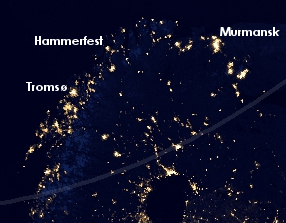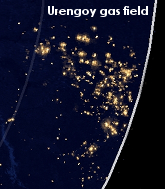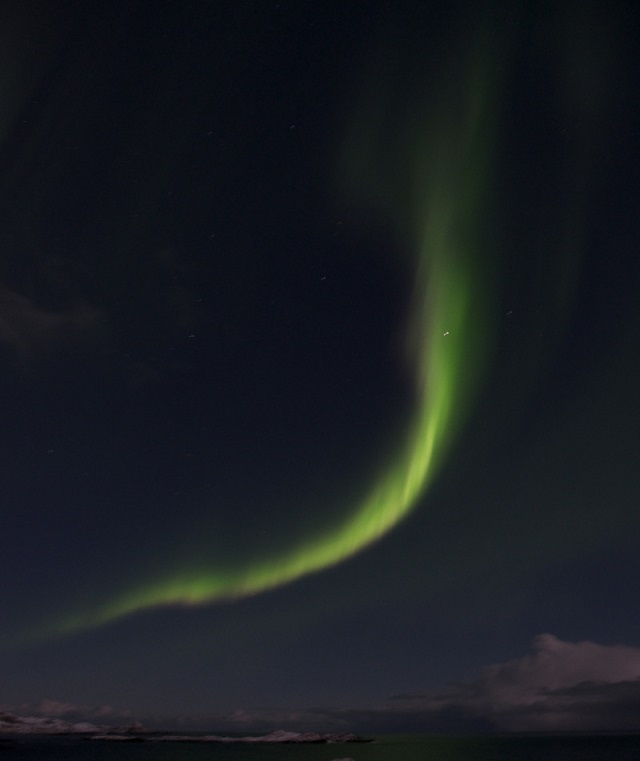The Arctic at Night
By Mia Bennett
In winter, the Arctic is considered to be a dark and dreary place save for when the northern lights shimmer and cascade across the polar skies. Yet even on a night when the aurora borealis are not putting on their performance, many parts of the Arctic are still brightly illuminated. Thanks to the Suomi National Polar-orbiting Partnership (Suomi NPP) satellite, jointly operated by NASA and the National Oceanic and Atmospheric Administration (NOAA), and put successfully into orbit on October 28, 2011, we can now see this in spectacular detail.
Whereas many phenomena in the Arctic were previously difficult for satellites to image in wintertime due to the lack of daylight, SUOMI NPP’s Day/Night Band can clearly detect manmade and natural developments, like shipping, oil and gas development, and sea ice break-up at night, with or without lunar illumination. Its resolution is a little bit coarse – 750 meters – but its sensitivity is impressive, allowing it to detect light from a source as small as a street lamp. You may have seen some images from the satellite already, such as of the Nile Delta aglow or of the Korean Peninsula, where the contrast in artificial lighting between the two countries is as stark as day and night.
The image at the top of this post, a composite of cloud-free images taken in April and October 2012, depicts the earth north of 60°N, with the Arctic Circle included for reference as well. I downloaded the GeoTIFFs from NASA Earth Observatory and displayed them in ArcMap using the Polar Azimuthal Equal Area projection.
 Norway’s well-developed Arctic coastline bustles with activity from the Lofoten Islands, past Hammerfest and around the North Cape (Nordkapp). The lights then continue along Russia’s northwest coastline on the Kola Peninsula. Here, the city of Murmansk – the largest north of the Arctic Circle – forms a distinct point of light.
Norway’s well-developed Arctic coastline bustles with activity from the Lofoten Islands, past Hammerfest and around the North Cape (Nordkapp). The lights then continue along Russia’s northwest coastline on the Kola Peninsula. Here, the city of Murmansk – the largest north of the Arctic Circle – forms a distinct point of light.
Iceland, too, has lots of activity around its coasts, especially near Reykjavik. However, south of Vatnajökull, Iceland’s ice cap, there is a desolate stretch of dark coastline, where the unforgiving sandur - glacial sands – stretch out to sea. In Canada, a few places twinkle in the Northwest Passage and along the Dempster Highway leading from Whitehorse to Tuktoyaktuk, on the edge of the Arctic Ocean.
Greenland is dark save for a tiny spot of light at Nuuk, its capital. The shape of the island overall, however, is visible thanks to the reflectivity of its ice cap. Ice reflects moonlight more readily than water, which is why in the above image, polar sea ice has a lighter shade of blue than the surrounding ocean. This phenomenon, the albedo effect, is the same reason why as the ice shrinks, less sunlight is reflected back into space. Instead, more is absorbed by the darker seas, which in turn expand and warm.
 But the places that blaze most brilliantly of all are the oil and gas production sites. Alaska’s North Slope appears brighter than even the big cities of Anchorage and Fairbanks. In Russia, the sources of light don’t seem to correspond at all with where the population centers are. Looking at this image, one might think that northwest Siberia was full of cities jammed up tight against one another. In fact, these are the lights of the Urengoy gas field, the second largest in the world. NASA already removed the gas flares from the composite image during processing, meaning that these are just the lights from places like camps and small settlements built around the hubs of industrial activity. Were the gas flares to be included, Urengoy would appear even brighter. Russia is the world’s biggest practicer of this wasteful activity, used to burn off natural gas produced during oil extraction that cannot be consumed or exported. It costs the country some $5 billion annually, according to the World Bank.
But the places that blaze most brilliantly of all are the oil and gas production sites. Alaska’s North Slope appears brighter than even the big cities of Anchorage and Fairbanks. In Russia, the sources of light don’t seem to correspond at all with where the population centers are. Looking at this image, one might think that northwest Siberia was full of cities jammed up tight against one another. In fact, these are the lights of the Urengoy gas field, the second largest in the world. NASA already removed the gas flares from the composite image during processing, meaning that these are just the lights from places like camps and small settlements built around the hubs of industrial activity. Were the gas flares to be included, Urengoy would appear even brighter. Russia is the world’s biggest practicer of this wasteful activity, used to burn off natural gas produced during oil extraction that cannot be consumed or exported. It costs the country some $5 billion annually, according to the World Bank.
Sadly, all of these artificial sources of light emitted from the ground can make it impossible to see the aurora. Skyscrapers and neon billboards glitter in global metropolises like New York City or Tokyo, but only a handful of stars are visible in the sky. Just as the Manhattan skyline will never compare to the Milky Way, I doubt the gas flares and bright lights of Urengoy will ever hold a candle to the northern lights. To see them in their full glory, you need to go somewhere unspoiled by artificial lighting. While it’s easier to find pitch black conditions in the Arctic than in most other regions in the world, the image above is a reminder that even places we think are wild and unpopulated – like northwest Russia – are often blindingly lit.
SUOMI NPP is so sensitive to low light that it can even detect swaths of bioluminscent plankton, which sometimes grace the Arctic’s seas. But I’m not sure if there’s any consolation in the fact that even though we can now manufacture satellites that detect everything from aurora to bioluminescence, we’ve become less able to see these phenomena from our earthly perches.
Mia Bennett, Blogger, http://www.cryopolitics.com
Picture credits: Mia Bennett

